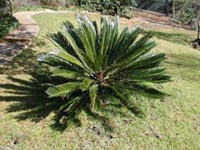Resource Library
Plant of the Week: Sago Palm
The University of Arkansas System Division of Agriculture does not promote, support or recommend plants featured in "Plant of the Week." Please consult your local Extension office for plants suitable for your region.
Plant of the Week
Sago Palm
Latin: Cycas revoluta

On a recent foray to the sunny South, I was able to renew my acquaintance with palms. Like most northerners I have only a nodding familiarity with palms, but one - the Sago Palm - I find especially intriguing because it masquerades as a palm but in reality is more closely related to a pine tree.
When the world was young and fossil fuels were being deposited in the ancient bogs of Pangea, the botanical tree of life branched. The new side shoot was at first spindly and struggled for survival, but eventually this new sprout - 19th century botanists later called them angiosperms - went on to dominate the flora of the modern world.
The main trunk of the tree of life did not wither and die but lost its preeminence in the botanical kingdom. These more ancient plants - the gymnosperms - remain with us in three distinct sub-branches of the tree of life - the ginkgo, the conifers such as pines, spruces and the like, and the cycad palms.
About 100 species of cycads exist today, with the most common being the Sago Palm, Cycas revoluta. Sago palm is native to the Old World tropics from Madagascar to Japan. Given enough time, this slow growing tree will form a trunk six feet in length. In China I was shown a sago palm reportedly 1000 years old. Trunks rarely branch, but if they do, the new shoot emerges from the base.
The evergreen, feather-like leaves are arranged around the stem in a whorl, producing a symmetrical rosette of leaves three to four feet across. The stiff, narrow leaflets are dark green on the upper surface with a single midrib down the center.
All cycads are dioecious, meaning individual plants are either of the male or female persuasion. In reading the technical descriptions of reproduction in cycads, I come away feeling as if there is some kind of botanical voyeurism involved amongst the experts. They are especially intrigued by the fact that the male sperm cell is the largest in all of biology, almost large enough to see with the naked eye.
The sago palm, so named from a Polynesian word used to describe a group of true palms from which an edible starch is produced, is grown outdoors in zones 9 and 10 and survives freezes to about 20 degrees Fahrenheit. The rest of us are required to use it as a houseplant if we wish to grow it.
As houseplants sago palms make excellent long-lived specimens. They are very slow growing, so be prepared to wait for at least a decade to see much of a trunk develop. Their tolerance of low humidity, low light and varying water regimes makes them well suited for use as a houseplant. Most plants grow considerably broader than tall, meaning they can eat up a fair amount of floor space in the living room. A solution to this space-hog problem is to grow them as bonsai subjects as do the Japanese.
During the spring and summer months, sago palms benefit from a summer vacation on the patio. Place them where they get high shade or at least protection from hot afternoon sun. While little is known about their response to fertilization, it seems logical to assume that an occasional feeding with a houseplant fertilizer during this summer will keep them well nourished and as vigorous as a sago palm can get. Scale insects can attack the plant but are not usually serious.
By: Gerald Klingaman, retired
Extension Horticulturist - Ornamentals
Extension News - February 7, 2003
The University of Arkansas System Division of Agriculture does not maintain lists of retail outlets where these plants can be purchased. Please check your local nursery or other retail outlets to ask about the availability of these plants for your growing area.